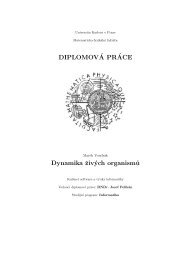Bachelor Thesis - Computer Graphics Group
Bachelor Thesis - Computer Graphics Group
Bachelor Thesis - Computer Graphics Group
Create successful ePaper yourself
Turn your PDF publications into a flip-book with our unique Google optimized e-Paper software.
are used. In any case, when no corresponding action can be found, an empty<br />
Action object is returned.<br />
Unlike the currently used PatternList, the active ActionMapping can be<br />
modified safely. The next time a gesture is performed, the corresponding action<br />
is determined according to the current state. This is beneficial as the user is<br />
able to see the changes done in the user interface immediately. To achieve good<br />
performance, the internal implementation uses QMap classes, which can be<br />
indexed directly by an Application and a Gesture.<br />
5.6 Commands<br />
Action commands have been designed to be modular and easily extensible.<br />
The interface is based on the command and prototype design patterns [1].<br />
There are two classes of commands:<br />
• ICommand is a basic command, which does not support configuration.<br />
It must implement the execute method. A finalize method, which can<br />
be overridden optionally, is also provided. This method is called when<br />
wheel gestures are performed. The purpose is to finalize the sequence<br />
of multiple command executions, each for one wheel-scrolling event. It<br />
gives the command an opportunity to restore any state it might have<br />
altered, such as releasing emulated key presses, etc.<br />
• ICommandConfigurable is an extended variant of ICommand, which<br />
is user configurable. It must implement methods, which store and restore<br />
the actual command configuration in XML. To present the configuration<br />
options in the user interface, the command implementation is supposed<br />
to fill a provided container with any widgets it may need. It must be<br />
also able to fill the widgets with the current configuration and to retrieve<br />
the configuration from the widgets. This is done by implementing a few<br />
virtual methods, prescribed by the interface<br />
Instances of the actual command implementations are managed by the CommandFactory.<br />
The factory is a globally accessible singleton, initialized by the<br />
Engine at start-up. The factory owns prototypes of all available commands.<br />
Other objects can browse the list of commands or directly request a certain<br />
command by its name. If it has been found, the prototype of the command is<br />
returned to the caller. Prototypes cannot be executed; they must be cloned to<br />
create a separate instance.<br />
A list of all commands with their descriptions can be found in the user’s<br />
manual. Some of the commands have been proposed in the goals, others have<br />
been designed while implementing the application.<br />
36
















